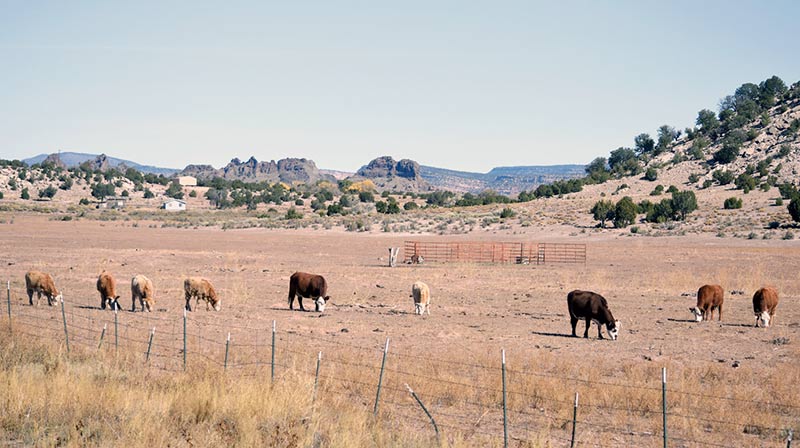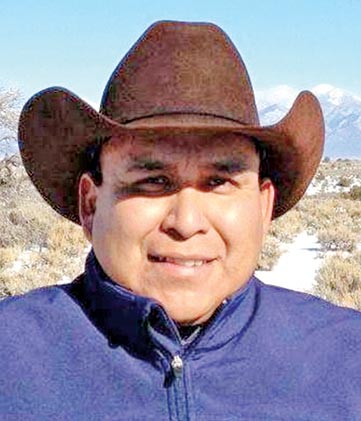
Beefing up the nation

Navajo Times | Ravonelle Yazzie A group of cattle graze on a Tuesday morning in St. Michaels, Arizona. A ranching expert believes that with more coordination of the available tribal and private resources, ranching could be a profitable enterprise for the Navajo Nation.
Expert: Ranching is untapped resource for Navajo

Navajo Times | Ravonelle Yazzie
A group of cattle graze on a Tuesday morning in St. Michaels, Arizona. A ranching expert believes that with more coordination of the available tribal and private resources, ranching could be a profitable enterprise for the Navajo Nation.
CHINLE
It’s common knowledge there are no jobs on the Navajo Nation. But to Delane Atcitty, that’s a bunch of bull.
“There are jobs at home,” declared Atcitty, a rangeland management consultant who spoke at last week’s Native American Farm and Ranch Training at Acoma Pueblo. “There’s always been a job at home.”
That job is ranching but most Navajos don’t really treat their ranches as a business, Atcitty said.

Delane Atcitty
If the tribe and individual ranchers could just “connect the dots” a bit, Atcitty contends, the vast rangelands and tribal ranches of the Navajo Nation could be producing a good living for both individual cattlemen and the tribe.
“We have everything we need right here,” Atcitty told the Times, “but we aren’t using it so it works together.”
At the moment, the Navajo Nation is crowded with tiny ranches competing for marginal grassland. There’s not much incentive to alternate pastures on the open range, Atcitty pointed out, because if you leave a pasture for the winter, someone else will drive his cattle onto it.
“It’s the tragedy of the commons,” he said.
So most people end up grazing as many cattle as they can over the summer and are left feeding hay in the winter. This is bad not only for the cattle and the rangeland, but for the rancher.
“People are choosing quantity over quality,” observed Atcitty, “when it actually almost cancels out. You can get almost as much for 50 good cows as you can for 100 bad cows, with a lot less work.”
Figuring the cow-cost
A lot of people, Atcitty noted, are not figuring out their cow-cost — the amount of money it takes to raise one calf to salable size.
“If you’re hauling water and feeding hay at $14 to $16 per bale,” Atcitty explained, “your cow-cost could be as high as $1,200 to $1,400. Then you turn around and sell it for $1,100. At that point, you may be living the ranch lifestyle, but you’re not a rancher.”
Diné small ranchers also tend to get too attached to their animals and keep them too long, Atcitty opined.
“I’ll be hanging out at the corral with someone, and they’ll say, ‘That’s Mabel. That one’s Gertie. We’re keeping Gertie around another year. Maybe she’ll have a calf.’
“Well, if Gertie doesn’t have a calf, you’ve spent $800 on her for nothing,” Atcitty said. “Once you start naming your animals, that’s it.”
Cattlemen tend to be independent types, Atcitty noted, but the reality is that in a place like the Navajo Nation, where resources are few and widespread, small ranches are not viable unless they can collaborate. Groups like the 14R, a coalition of ranches in Nahata Dziil, make more sense.
“Let’s say you pack four or five cows in a trailer and drive 50 miles to Belen to sell them,” Atcitty postulated. “You’ve probably spent $120 on fuel, and if you brought along a helper or your family, that’s another $80 in food. You have to figure your time is money too.”
The alternative?
“Throw in with some other producers, rent a semi, and deliver 50 head,” he said.
Cooperatives can go in together for things like vaccines and dewormers, minimizing cost by buying in bulk.
To read the full article, pick up your copy of the Navajo Times at your nearest newsstand Thursday mornings!
Are you a digital subscriber? Read the most recent three weeks of stories by logging in to your online account.








 Highway 264,
Highway 264, I-40, WB @ Winslow
I-40, WB @ Winslow